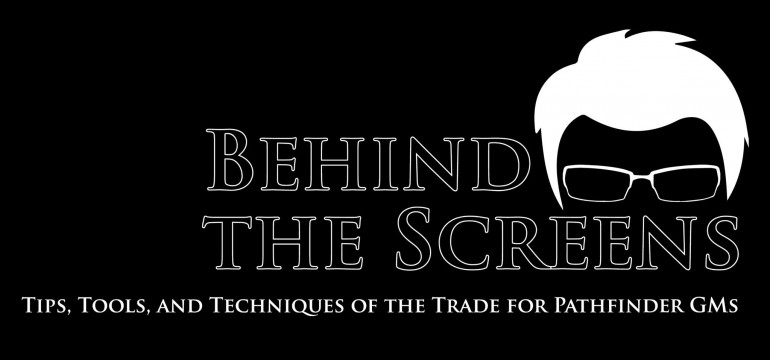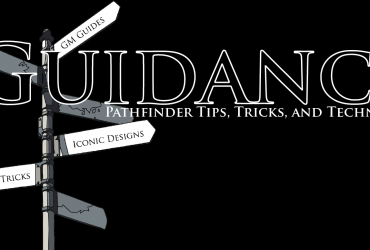So Alex’s philosophy of having multiple subcategories for his column is starting to win me over. But I still want to keep this blog related to GMing advice and such. Last time, I started “Prep With Me”, a type of article dealing with how and why I prep adventures the way I do but also as a way to keep my notes in one place (here on the blog). This week I want to continue expanding on that idea of having notes easily accessible to me but also for your reading pleasure. So I’m introducing “Sidebar”, a type of article that deals with various rules, tables, or things that a GM should need to reference every now and then. I think that’s a fair enough catch-all mission statement for now. Not quite as directed as, “Prep With Me”, but I’ll hone my focus as things progress.
Today I want to jot down some house rules I’ve been percolating on lately. As some of you know I’ll be starting Hell’s Rebels soon (probably in January) so it’s a good time to introduce my players to changes in how the game’s going to be run. While I’m at it, I figure I’ll post my musings here for your own ruminations. Some of these are simple fixes better represent how I want scenes within the game to run. Some of them are fairly radical and come from my observations of how things work in other game systems. So with out further adieu, let’s dive into the New House Rules for 2016.
Out with the Grid!
I’ve started not liking battle mats so much. Something about the need to count squares for movement, for range, or whatever seems to take me out of the moment. Verticality is also sort of a problem because it can be difficult to represent height on a 2D battle space. The solution for this comes from my foray into wargaming. Ain’t no grids in wargames. To do this I’m scaling the game to to 1:60th. Which is just a fancy way of saying that 1 inch on my table is 5 feet of space or, basically how the game assumes distances are measured on a battle mat.
So what does this change? Not a lot. But a lot. What do I mean by that? Well the core distance measuring is basically the same. If your character has a 30ft move they would get to move up to 6 squares as a Move Action, which is approximately 6″ across the table. Unless you move diagonally, which under the grid system is sort of weird and handwavy – because diagonals. In the gridless system I’m envisioning, you just move your character in 1″ increments, whatever direction. Does that mean you’ll need to start bringing measuring tape to your games? Yep. But it also means you can account for vertical movement up and over 3D terrain (the presence of which has been becoming increasingly more likely in my games).
Measuring in inches rather than squares is also nice for things like long distance lines and area of effects. Have you ever had to count squares for a 180 ft Lightning Bolt? It’s come up more than once in our games. Or how about a Fireball? Cone of Cold? All sorts of round shapes look weird translated on a grid. Is it a perfect fix? No, not even remotely. Is it more work? Maybe? I’ve gotten used to measuring movement of individual models through wargaming so I know it’s not a huge change to adapt to this sort of distance measuring. Will my players be okay with it? Probably? At least I hope so. Because a lot of the other smaller house rules I’m going to talk about today hinge off of this one.
Scaling Threats!
Corollary to measuring and occupied space, I wanted to adjust the rules to reflect that not only do larger creatures have longer reach but also more of a footprint. Think about it. The stride of a 4’6″ person is much shorter than the stride of a 6″6 one. The shorter person will have to expend more effort to cover the same amount of distance. The taller person can occupy more space. So to adapt to a gridless game I’m having Medium creatures threaten 1″, Large creatures threaten 2″, and so on upwards. Small creatures threaten only 1/2″ while anything smaller than that threaten not at all.
Similarly I wanted to shift slightly away from the static nature of combat and incentivize at least a little bit of movement. 5ft steps are being adjusted into 1/3 movement. So a character with a base movement of 30 ft (which is now 6″) can shift 2″ as no action without provoking an AoO. This gives some potential for bigger things or faster things to move around the battlefield while still remaining lethal, hopefully moving away (hah!) from the static plant-feet-and-swing paradigm.
Moving Swiftly
Another thing I wanted to address was how strange it was that I could move to a closed door, open it, but not be able to move through it. Or not being able to rummage through your pack while on the move. So a quick change is that now players will be able to take Swift or Move equivalent actions while on the move and still finish their movement so long as they move their base movement distance or less. So a character with a move of 6″ can move 2″ to a door, open it, and then 4″ into the room beyond. They can’t take a Standard action because they’ve used two Move equivalent actions. But at least their movement isn’t stopped by the door.
Charge!
Charging has a super strict set of rules in Pathfinder. You need a straight, uninterrupted line from where you are to where your opponent is at the beginning of your turn. It has to be open and non-difficult terrain and there can’t be anything in between, no allies, no enemies. Straight and uninterrupted. I get it, a charging warrior needs momentum to gain the benefits of a headlong attack. But I think the rules are too strict. So, charges are still double your base movement. But only the last 6″ need to be in a straight and unobstructed line. That way if there’s something in the way between you and your enemy and you have the available movement, you can maneuver into a viable charge position before making the charge.
Blind Spot
This last rule is probably going to be the most controversial and difficult to rule (aside from the gridless bit at the beginning). The rule is facing. I don’t like how Flanking works. And I find the rules for Stealthing to a target a little too cumbersome. The fix I’m thinking of implementing is that which way your character is facing matters. So character’s miniature have a “front arc” and a “rear arc”. If you’re being attacked from your front arc, no problem, no penalties. But if the attack originates from your rear arc then you’re considered flat-footed. Likewise a character can only make AoO’s against things moving through their front arc. Some feats (like maybe Combat Reflexes) will allow you to not suffer from penalties associate from rear arc attacks. I’m not quite sure yet.
So that’s it for now, I think. There are some more thoughts I’d like to get down eventually, but that’s for another day. As always, I love feed back. Let me know if you like what you’re seeing in the comments section below!





